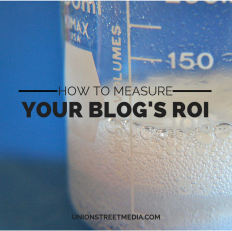How to Measure Your Blog’s ROI
Real estate agents wear many hats. They are salespeople, negotiators, and sometimes tour guides. I hope you’re a blogger. And I wrote this post to teach you how to be a mad scientist with your blogging data.
The only way you can get your blog noticed is to continually make your blog better, and the only way to continually make your blog better is to experiment with content and measure your blog’s ROI on a consistent basis.
First, determine your blog’s key performance indicators (KPIs). In other words, determine which metrics you’ll use to measure your blog’s success. Common KPIs for blogs include number of comments, number of sessions, and bounce rate. Secondary KPIs could be number of pages viewed and time spent on page.
Number of comments.
This one’s easy: the more people who comment on your blog and interact with you, the more they are engaged with your brand. You want a high number of comments (bots and spam not included) on each of your posts.
Number of sessions.
A session is defined as the actions that take place between the time a visitor lands on your blog and exits the blog. However, the number of actions that take place in a session don’t affect the number of sessions. For instance, if a person visits your blog, reads one post and leaves, it counts as one session. On the other hand, if a person visits your blog, reads two posts, subscribes to your RSS feed, reads another post, and then exits your blog, it still counts as one session. Still, the number of session on your blog show how many people come to your blog for information – whether or not they are new or returning visitors. Just like the number of comments, you want a high number of sessions to show that readers are engaging with your blog.
Bounce rate.
This metric goes hand-in-hand with number of pages viewed. The bounce rate for your blog is calculated based on how many people only visit one page within your blog and immediately leave your site. The bounce rate for blogs tend to be higher when people land on your blog from organic results on Google or Bing. This trend occurs because people tend to look for a select set of information when they search on a search engine.
For example, a home buyer might search Google for “ways to improve curb appeal.” One of your blog posts appear on a search engine results page, and they click on the link to read your article. Once they read your article, they have all of the information they need, and they exit the page. Because the visitor only read one page on your blog, this counts as a bounce.
In this case, examining the time spent on page will give you a better idea about how engaged people are with your blog. If the time spent on a certain article is less than 30 seconds, this might hint that visitors are not satisfied with your post. If the time exceeds 1 or 2 minutes, then it shows that the visitor actually took the time to read your post. Like we mentioned above, a bad page title could set the wrong expectations for your content and create unhappy readers. Unhappy readers are more likely to bounce from your blog, drive up your bounce rate, and shorten the time spent on page.
Example experiment:
Let’s say you want to decrease your bounce rate and increase the number of pages viewed on your blog. Consider placing CTAs within your blog posts and link to other areas of your website from your blog.
Maybe you want to drive more traffic to your Recommended Searches page, and you just wrote a blog post about waterfront homes in your area. Create a hyperlink from the “waterfront homes” phrase in your post and link it to the “waterfront homes” Recommended Search. Not only will this decrease your bounce rate and increase the number of pages viewed by visitors, but it will drive more traffic to your Recommended Search pages and give more exposure to your inventory.


